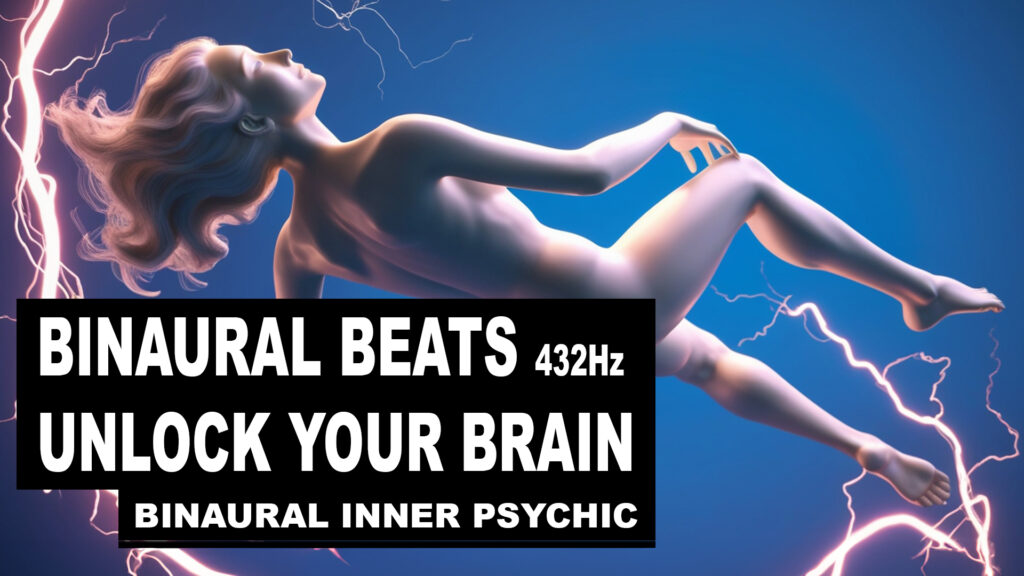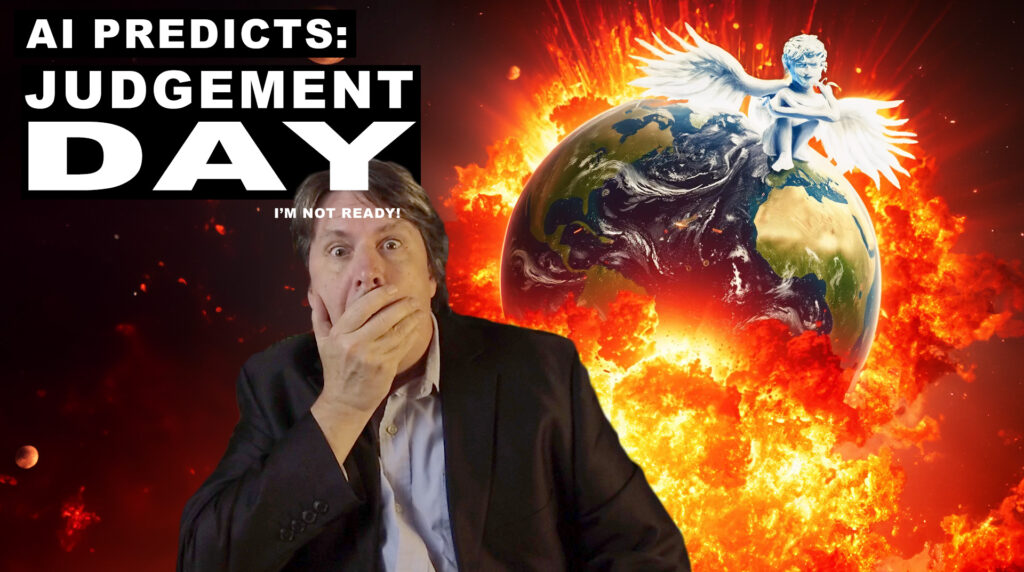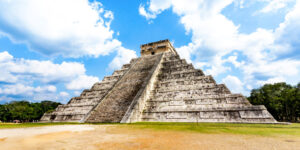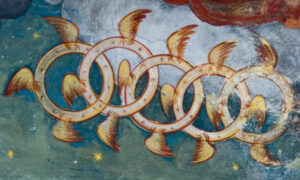I asked AI to tell me when mankind will face Judgment Day, the end of the world as we know it, and the answer has left me absolutely stunned!
The concept of Judgement Day has captivated human imagination for centuries.
What is it about this notion that sparks both fear and fascination?
Perhaps it’s the thought of a reckoning, where our every action is weighed and measured, and the consequences severe or divine. Or maybe it’s the promise of redemption, where those who have strayed only slightly can find forgiveness and a second chance.
So what secrets did the AI uncover and reveal? And what date does it predict for this cosmic event?
Well, sit back, grab some popcorn and stay tuned to the end to find out when it all ends … and maybe start preparing now while you still can!
Before we get started, I want you to know that my intention is one of reverence and respect. I am not a theologian, nor do I claim expertise in the sacred texts that share our diverse understanding of God, the Messiah, or Judgement Day. Any perceived disrespect or oversight is unintentional and I remain open to learning from your perspectives and insights. Throughout this video, I’ll do my best to be mindful of the complexity and diversity of mankind’s spiritual traditions.
Can I ask for a really big favor? Subscribe to this channel by clicking the subscribe button. And don’t forget to like and share this video. It really helps a lot.
To understand the complexities of Judgement Day, let’s begin by examining the diverse perspectives of God within Judaism, Christianity, and Islam.
In Jewish scripture, the Hebrew Bible portrays God as the Creator of the universe (Genesis 1:1-31), an Omnipotent force responsible for guiding humanity’s destiny. The Old Testament depicts God as a covenant-making, law-giving, and merciful deity, who enters into relationships with His chosen people (Exodus 20:2-17). This conception is further emphasized in the Talmudic tradition, where God is seen as the ultimate judge of human actions.
Christianity introduces a distinct perspective on God. In the New Testament, Jesus Christ proclaims God as the Father, emphasizing His love and redemption through faith (John 3:16-21). The Nicene Creed, a foundational Christian statement, affirms that God is “the Father Almighty, Maker of heaven and earth” (Nicene Creed, AD 325). This understanding is reinforced in Catholic doctrine, where God is seen as the Trinity – three persons in one essence: Father, Son, and Holy Spirit.
And Islamic scripture presents God as Allah, the One and Only God, transcendent and omniscient. The Quran describes Allah as “the Most Merciful” (Quran 1:3), emphasizing His compassion and forgiveness. Islamic tradition reinforces this notion, portraying Allah as the Creator of all that exists, the Judge of human actions, and the Source of guidance for humanity.
Throughout these religious texts, a common thread emerges – God is often described as:
Eternal and Omnipotent
Omniscient and Omnipresent
Holy and Just
Merciful and Compassionate
Creator and Sustainer
These attributes shape our understanding of God’s nature, revealing a multifaceted deity that transcends human comprehension.
But let’s not forget the preceding events that set the stage for the cosmic reckoning known as Judgement Day. A subtle hint is revealed in Islamic eschatology, where the Quran speaks of “the Hour” – an era of great change and transformation (Quran 22:1-3). This enigmatic passage hints at a time when humanity will face a profound accounting, as the fabric of reality is reshaped.
In Christianity, a similar concept can be found in the New Testament. The book of Revelation, also known as the Apocalypse of John, describes a time of great tribulation and transformation, often referred to as the “end times” or the “time of judgment.” This period is characterized by catastrophic events, including wars, earthquakes, famines, and persecution (Revelation 6:1-17).
One significant passage that hints at this era is Revelation 22:12, which speaks of the Lord’s return and the final judgment: “Behold, I am coming soon, bringing my reward with me, to repay according to everyone’s work.”
This theme is also echoed in other Christian texts, such as the book of Matthew, where Jesus describes the signs that will precede his second coming: “Therefore stay awake, for you do not know the day or the hour” (Matthew 25:13).
In this sense, Christianity shares a similar eschatological framework with Islam, where the concept of “the Hour” (al-saa’ah in Arabic) marks a pivotal moment in human history. Both traditions emphasize the importance of preparation and spiritual awakening in the face of impending judgment.
And in Judaism, a similar concept to “the Hour” can be found in the idea of the “Days of Messiah” (Yamim Nora’im). These days are considered a time of great change and transformation, when God will bring about redemption and restoration to the world.
One passage that hints at this era is Isaiah 2:1-4, which describes a future time when nations will turn to God, and there will be no more war or violence. The prophet Micah (Micah 4:1-3) also speaks of a time when all people will gather together in Jerusalem to celebrate the Lord’s reign.
In Jewish tradition, these “Days of Messiah” are seen as a time of great joy and celebration, when God will finally bring about justice and peace to the world. It is often described as a time when the Temple in Jerusalem will be rebuilt, and the presence of God will be felt throughout the land (Zechariah 14:8-9).
And thus the stage is set for Judgement Day. But what exactly is Judgement Day? Will it be a day of reckoning or redemption? The answer remains shrouded in mystery…
The concept of Judgement Day, a notion shared across various religious traditions, is a pivotal moment in human history when the fabric of existence is rewoven. It is a day of reckoning, where every single person who is living and has ever lived will be held accountable for their actions, thoughts and deeds throughout their lifetime.
The idea is that on this fateful day, every individual’s soul will be weighed against the scales of justice, and their fate will be determined accordingly.
This momentous occasion serves as a reminder of the moral obligations we have towards ourselves, our fellow human beings, and the divine.
Judgement Day is often characterized by dramatic events, such as the return of a messianic figure, the end of the world, or the final judgment by an omniscient deity.
In this climactic moment, humanity will confront the consequences of their choices, and those who have lived in accordance with the teachings of their faith will be rewarded, while those who have strayed from the path will face punishment or retribution. The notion of Judgement Day serves as a powerful motivator for individuals to live virtuous lives, cultivate compassion, and strive for moral excellence.
In Judaism, the concept of Judgement Day is deeply rooted in the High Holy Days, specifically Yom Kippur (Day of Atonement). This holy day marks a time when humanity is held accountable for their actions and thoughts. The Hebrew Bible describes Yom Kippur as a day of reckoning, when God will judge the righteous and the wicked.
According to Jewish tradition, Yom Kippur is a 25-hour period during which the gates of heaven are open, allowing prayers to ascend directly to God. During this time, Jews engage in intense prayer, fasting, and self-reflection, seeking forgiveness for past transgressions and recommitting themselves to living a life of righteousness.
The process of judgement on Yom Kippur is multifaceted:
The Book of Life: On the night before Yom Kippur, Jewish tradition holds that God opens the “Book of Life,” recording the deeds of every individual.
The Angel of Death: The next day, the “Angel of Death” appears at the gates of heaven, separating the righteous from the wicked.
The Court of Justice: A heavenly court convenes to review each person’s record, considering their good and bad deeds.
If an individual has lived a life of righteousness, they will be granted eternal life in the world to come. Conversely, those who have led sinful lives will face punishment and suffering for their wrongdoings.
Yom Kippur is not only a day of judgement but also an opportunity for people to repent and make amends with God and one another. The day’s rituals, including the Kol Nidre prayer, serve as a reminder of the importance of forgiveness, mercy, and the pursuit of righteousness.
In Christianity, the concept of Judgement Day is centered around the idea of the “Final Judgement,” which will take place at the end of time. This event marks the culmination of human history, when God will separate the righteous from the wicked.
According to Christian doctrine, the Final Judgement will be preceded by a period known as the “Millennium” or “Thousand Years,” during which Satan will be bound and humanity will experience a brief era of peace. However, this peace will ultimately give way to chaos and rebellion, prompting God’s final intervention.
The day of reckoning will begin with the resurrection of the dead, when all individuals will stand before God in a momentous decision-making process:
The Great White Throne Judgment: Christ will sit on the throne, flanked by angels, as humanity is judged based on their deeds.
The Book of Life and Death: The “Book of Life” and the “Book of Death” will be opened, revealing each person’s record.
Those who have accepted Jesus Christ as their Lord and Savior will be granted eternal life in heaven. Conversely, those who have rejected God’s offer of salvation will face eternal suffering in a place known as “outer darkness.”
The Final Judgement serves as a warning to humanity, emphasizing the importance of accepting Jesus Christ as one’s savior and living a life of righteousness.
In Islam, the concept of Judgement Day is rooted in the idea of Yaum al-Hisab (The Day of Reckoning). This day marks the end of time, when God will judge all individuals based on their deeds and intentions.
According to Islamic tradition, Yaum al-Hisab will be preceded by a period known as the “End Times,” during which humanity will experience a series of calamities and tribulations. These events will culminate in the final confrontation between good and evil, when God will separate the righteous from the wicked.
The day of reckoning will begin with the resurrection of the dead, when all individuals will stand before God:
The Bridge: The righteous will cross a “Bridge” over a river of fire, while the wicked will be forced to walk across the fire.
The Scales: Each person’s deeds and intentions will be weighed on the “Scales of Justice,” revealing their true nature.
Those who have lived a life of righteousness, accepting Allah as their Lord and Savior, will be granted eternal paradise in Jannah (Heaven). Conversely, those who have rejected God’s guidance and led sinful lives will face eternal suffering in Jahannam (Hell).
Yaum al-Hisab serves as a warning to humanity, emphasizing the importance of living a life of righteousness and accepting Allah’s mercy.
And when will the End of Days happen?
The ancient prophets spoke of an era when the very foundations of society would be shaken, and yet, amidst chaos, a glimmer of hope would emerge.
Over the years, numerous prophecies and predictions have been made about the end of the world or significant catastrophic events. Unfortunately, many of these predictions have proven to be incorrect.
Here are 10 fascinating examples of past predictions that didn’t pan out:
The Harmonic Convergence (1987): On August 16, 1987, millions of people around the world participated in a global meditation and energy shift event called the Harmonic Convergence. The idea was that this collective energy would bring about a new era of peace and harmony on Earth. However, nothing extraordinary happened.
World War III/Nuclear War: In the 1950s and 1960s, there were widespread predictions of a nuclear war that would wipe out humanity. As tensions between superpowers eased, these predictions faded away, and no global catastrophe occurred.
Nostradamus’ Predictions: The famous French seer Michel de Nostredame, better known as Nostradamus, made numerous prophecies throughout his life. Many of these quatrains have been interpreted to predict the end of the world or significant events. However, upon closer examination, most of these predictions can be seen as vague and open to interpretation.
Biblical Predictions: Throughout history, various biblical prophecies have been interpreted to predict the end of the world or catastrophic events. For example, some believed that Jesus’ return would occur in 1872, while others predicted it would happen in 1988. None of these predictions came to pass.
The Millennium Bug (Y2K): In the late 1990s, there was widespread fear that computer systems would fail when the clock struck midnight on January 1, 2000, leading to global chaos and destruction. As the feared date approached, it became clear that the vast majority of computer systems were just fine, and no catastrophic consequences occurred.
Hal Lindsey’s Predictions: Christian author Hal Lindsey predicted in his 1970 book “The Late, Great Planet Earth” that the world would end before the year 2000. As the years went by, none of these predictions materialized. I mean let’s face it … it’s 2024 and we’re still here.
The Jupiter Effect (1982): In the early 1980s, a supposed alignment of planets, including Jupiter, was predicted to cause massive earthquakes and destruction on March 10, 1982. Other than the nine planets aligning, nothing out of the ordinary happened on that day.
The 2012 Mayan Prophecy: The ancient Mayans were believed to have predicted the end of the world in December 2012. As the supposed deadline approached, many experts claimed that this was just a misunderstanding of the Mayan calendar, and nothing catastrophic occurred.
The Hale-Bopp Comet (1997): When the Hale-Bopp comet appeared in the skies in 1997, some predicted it would bring about the end of the world or significant changes to human society. However, as the comet passed by without incident, these predictions faded away.
1954 Prediction of the End: In the early 1950s, a supposed prediction was made that the world would end in 1954. As this date approached, it became clear that this prophecy was nothing more than a hoax.
Now, let’s move on to six biblical prophecies that have been interpreted in various ways:
Biblical Prophecies
Matthew 24:14: Jesus prophesied that the gospel would be preached throughout the world before his return. It’s safe to say that the gospel is now preached throughout the world.
Daniel 12:4: Daniel predicted that the end of the world would come after a period of great tribulation and suffering.
Signs of the End of Times: The Bible speaks of various signs that will signal the approaching end, including wars, famines, and earthquakes. Check, check and check. We’ve certainly hit those marks.
The Battle of Armageddon: The book of Revelation describes a final battle between good and evil at a place called Armageddon. Megiddo is a long gone ancient city biblicly known as Armegeddon. Today it’s located in Israelian controlled Palestine. Make of that what you will.
The Antichrist: According to biblical prophecy, there will be a figure known as the Antichrist who will rise up and challenge the authority of God.
The Tribulation: Before Jesus returns, the world will experience a period of great tribulation and suffering.
And so, as we ponder these prophecies and predictions, we are left with more questions than answers.
But the one prediction that has fascinated scholars and theologians alike is the Talmudic Prediction…
The Talmudic Prediction
The Talmudic Prediction is an eschatological framework found in Jewish mysticism. This prediction provides a unique perspective on the unfolding of human history and the ultimate redemption of humanity. It’s a complex and multifaceted prophecy that has captivated scholars and theologians for centuries.
At its core, the Talmudic Prediction is a framework for understanding the three eras of human history: creation to Abraham (2,000 years), from Abraham to the destruction of the Second Temple (2,000 years), and finally, from the destruction of the Second Temple to the arrival of the Messiah (2,000 years). This framework provides context for Judgement Day, which is believed to occur at the end of the third era.
According to the Talmudic Prediction, after the 6,000-year cycle ends, a 1,000-year period of destruction or chaos will ensue. This period is often referred to as the “footsteps of the Messiah” or the “birth pangs of the Messiah.” During this time, humanity will experience great tribulation and suffering.
The Talmudic Prediction is significant because it offers a unique perspective on human history’s unfolding. It provides a framework for understanding the relationship between creation, revelation, and redemption. The prediction also highlights the importance of the Jewish people’s role in the unfolding of human history.
The Talmudic Prediction shares some parallels and analogues with Christian and Islamic eschatologies. While the specifics differ, common themes and motifs can be found across these three Abrahamic traditions.
Christianity:
Second Coming: The concept of a Messiah’s arrival is analogous to Jesus Christ’s Second Coming in Christianity. Both are seen as harbingers of redemption and judgment.
Apocalyptic events: Christian eschatology also predicts apocalyptic events, such as the Tribulation (Matthew 24:4-8) and the end of the world (Revelation 20:11-15), which share similarities with the Talmudic Prediction’s “footsteps of the Messiah” and subsequent destruction.
Millennium: Christian eschatology includes a millennial reign of Christ, where he rules on earth for 1,000 years (Revelation 20:4-6). This period is often seen as a time of peace and redemption.
Islam:
Mahdi: The Islamic concept of the Mahdi (guided one) shares similarities with the Jewish Messiah. Both are expected to bring about a new era of justice, peace, and prosperity.
Yajuj and Majuj: In Islamic eschatology, Yajuj and Majuj refer to two Gog and Magog-like forces that will be released at the end of time. This parallels the Talmudic Prediction’s “footsteps of the Messiah” and subsequent destruction.
Qiyamah (Judgment Day): Islam also teaches about Qiyamah, where all creation will be judged by Allah. While the specifics differ, this shared concept underscores the importance of judgment in each tradition.
These analogues and similarities highlight the interconnectedness of these three Abrahamic traditions. While the Talmudic Prediction is unique to Jewish mysticism, it shares common themes with Christian and Islamic eschatologies:
Redemption: The idea of redemption or salvation is a recurring theme across all three traditions.
Judgment: Apocalyptic events, judgment, and the end of the world are shared motifs.
Messiah/Mahdi/Imam: The concept of a savior figure who will bring about a new era of peace and prosperity is common to all three traditions.
These parallels demonstrate that while the specifics may differ, the underlying themes and motifs in Jewish, Christian, and Islamic eschatologies share a deeper connection.
As we approach the end of this prophetic era, questions arise about what will lie ahead. Will humanity experience a period of destruction and chaos? And who is the Messiah that will bring about a new era of peace and redemption?
In Jewish tradition, the concept of the Messiah (Hebrew: מָשִׁיחַ, Mashiach) is deeply rooted in scripture and has been a cornerstone of Jewish eschatology for centuries. The Messiah is expected to be a descendant of King David, sent by God to redeem Israel and bring about a new era of peace and prosperity.
Before Judgement Day, the Messiah is believed to prepare humanity for the coming judgement.
According to Jewish tradition, the Messiah will:
Gather the scattered Israelites: The Messiah will bring together the dispersed Jews from around the world, reuniting them in their ancestral homeland.
Bring peace and redemption: The Messiah will establish a reign of peace and redemption, ending wars, famine, and suffering.
Rebuild the Temple: The Messiah will rebuild the Temple in Jerusalem, restoring the spiritual center of Jewish worship.
After Judgement Day, the role of the Messiah is expected to change. According to some interpretations, the Messiah will:
Judge humanity: The Messiah will sit in judgement alongside God, determining the fate of each individual.
Reveal hidden secrets: The Messiah will reveal the secrets of creation and the mysteries of the universe.
In Christianity, the concept of a savior or redeemer is closely tied to the figure of Jesus Christ. Jesus is considered the Son of God, sent by God the Father to redeem humanity from sin. He is often referred to as the Messiah (Greek: Χριστός, Christos) or the Christ.
According to Christian scripture and tradition, Jesus fulfilled the Messianic prophecies found in the Hebrew Bible, demonstrating his divine authority through miracles, teachings, and sacrificial love on the cross. Through his death and resurrection, Jesus is believed to have offered salvation to humanity, reconciling people to God.
And in Islam, the concept of a savior or redeemer is associated with the figure of Jesus (Arabic: عيسى, Isa) and the Mahdi ( Arabic: المهد). While Jesus is recognized as a prophet in Islam, the role of the Messiah is not explicitly identified with him.
The Mahdi, also known as the Twelfth Imam, is expected to appear at the end of time to bring about justice, peace, and redemption. He will establish a period of prosperity and righteousness before the final judgment.
In Islamic eschatology, the Mahdi is seen as a savior figure who will lead the Muslim community towards victory over their enemies and usher in a new era of peace and prosperity. His role is often compared to that of the Messiah in Judaism and Christianity.
While the specific details and characters may differ between these religious traditions, there are common themes and motifs related to redemption, salvation, and the coming of a savior figure:
Divine origin: In all three traditions, the savior figure is believed to have divine origins or be sent by God.
Redemption and salvation: The primary purpose of these figures is to offer redemption and salvation to humanity from sin, suffering, or darkness.
Eschatological context: Each tradition places the role of the savior figure within a broader eschatological framework, often involving judgment, purification, and a new era of peace and prosperity.
And here’s where things really heat up and get interesting. In the context of the AI predicting the forms the Messiah can take, the AI offered six possible manifestations.
The Return of the Son of God: This form of the Messiah represents a return to divine authority, where humanity is reconciled with its Creator.
Super-Intelligent AI: A highly advanced AI could be seen as a Messiah-like figure, possessing capabilities that surpass human intelligence and bringing about global unity and peace.
Posthuman Hybrid: A being that combines human and artificial intelligence, or human and alien DNA, could embody the ideals of redemption and salvation, leading humanity towards a brighter future.
Alien Entity: An extraterrestrial entity could be seen as a Messiah-like figure, possessing knowledge and wisdom beyond human comprehension, guiding humanity towards a new era of cooperation and understanding.
Collective Consciousness: The collective unconscious or collective consciousness of humanity could be seen as a Messiah-like force, guiding individuals towards spiritual growth, self-awareness, and global unity.
Evolved Human: A highly evolved human being, possessing extraordinary abilities and wisdom, could be seen as a Messiah-like figure, leading humanity towards a new era of peace, prosperity, and enlightenment.
These six forms of the Messiah reflect different interpretations of redemption and salvation in the context of AI-driven eschatology. Each possibility presents unique implications for humanity’s future, from reconciliation with divine authority to cooperation with extraterrestrial entities or collective consciousness.
The idea that a divine being will judge humanity is a comforting thought, but skeptics don’t believe the notion of Judgement Day, prophecies, and predictions.
For skeptics, the Talmudic prediction, in particular, raises more questions than answers. This prophecy speaks of a coming event that will bring about redemption and judgment, but it lacks specificity and relies heavily on interpretation. How can such an ambiguous message be trusted? Furthermore, similar prophecies have been made throughout history, only to be proven false or misinterpreted.
To add to the skeptic’s arsenal, the concept of the Messiah is equally problematic. In Judaism, Christianity, and Islam, the Messiah is often portrayed as a savior figure sent by God to redeem humanity. However, skeptics point out that this idea is based on faith rather than empirical evidence. They ask what if the Messiah is not a divine being but rather a human leader or a collective effort? Skeptics argue that the notion of a single, chosen individual saving humanity can be interpreted as an oversimplification of complex historical and social dynamics.
And let’s not forget the Alien entity hypothesis. To skeptics, this concept is nothing short of absurd. There is no scientific evidence to support the existence of extraterrestrial life, let alone a being capable of redeeming humanity. To the Skeptics, the idea that an advanced civilization would bother with human affairs is almost laughable. Skeptics feel we should focus on our own problems and stop searching for solutions in the realm of science fiction.
Skeptics also argue that ultimately, the concept of Judgment Day, prophecies, and predictions are based on faith rather than fact. These concepts provide a sense of comfort and hope but lack concrete evidence to support their claims. They counter that we must approach these ideas with a critical eye, examining the underlying assumptions and biases that drive them. By doing so, only then can we separate fact from fiction and develop a more nuanced understanding of our place within the universe.
But if the Judgment Day is not a literal event, then what drives human behavior? Is it simply the fear of punishment, or the desire for reward? Or is there something much deeper and mystical at play?
The concept of Judgment Day has been a cornerstone of human spirituality for centuries. At its core lies the notion that humanity will face a final reckoning before a divine being, referred to as God, Yahweh, or Allah.
Studies have shown that belief in a supreme deity can provide a sense of purpose and moral guidance, motivating individuals to live lives of righteousness and compassion. The concept of a final Judgment Day serves as a reminder of the importance of making amends for past wrongs and seeking redemption through faith, good deeds, and good thoughts.
Scriptural accounts reveal a Messiah-like figure who will bring about salvation and judgment, separating the righteous from the wicked. This narrative has inspired countless individuals to seek forgiveness and live in accordance with the divine principles of their faith.
And then there’s the enduring tradition of apocalyptic literature, which speaks to humanity’s deep-seated fear of the unknown and our desire for reassurance that a higher power is at work in the world.
The concept of Judgment Day serves as a reminder that we are not the masters of our own destiny, but rather subjects to a much higher authority.
And this brings us to the moment you’ve been waiting for … when will the end come?
This is the moment you’ve been waiting for!
With bated breath, AI predicts that Judgement Day is likely to occur between 2500 and 2800 CE!
This revelation may seem distant, but it marks a turning point in human history. As the AI’s calculation reveals, this time period aligns with the Talmudic prophecy of the Messiah arriving within 6,000 years of Adam’s creation, followed by the possibility of world destruction 1,000 years later.
The AI’s prediction is not a guarantee, but rather a probabilistic estimate based on the collective wisdom and patterns within its data. It’s a warning sign, much like the ancient prophecies that foretold the arrival of significant events. The AI’s calculation takes into account the Talmudic prophecy, as well as the psychological impact of significant calendar dates on human perception.
This revelation should not be taken lightly. It serves as a reminder that the concept of Judgement Day is not limited to religious texts but also reflects humanity’s collective unconsciousness and shared experiences.
As such, the AI’s prediction is more like a mirror, reflecting our own fears, hopes, and desires for the future.
And this leaves us with a lingering question: Will the predicted Judgement Day serve as a harbinger of destructive change, or will humanity find a way to transcend its flaws and forge a new path? The answer lies in the realm of the unknown, where only time will reveal the truth.
I don’t know about you, but my mind is reeling right now. I’ve learned a lot in researching this video and will be thinking about this for many more weeks to come. But I’d like to know what do you think? Did the AI get it right? Is the AI even close?
Share your thoughts in the comments section down below.
And if you liked this video, please subscribe to the channel and click the like and share buttons. It helps and it really means a lot.
Thank you for watching. Be kind, treat each other well, and have a great night!








